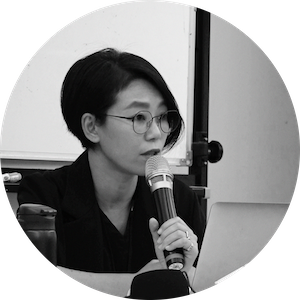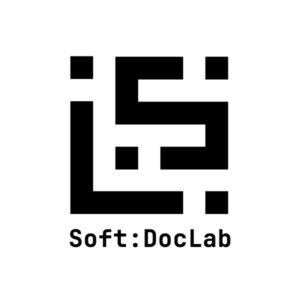亞洲轉型媒體實驗室 系列演講側記
離散語碼:
媒體筆作為點狀書寫主體
2022.05
// 講者—林欣怡 國立陽明交通大學應用藝術研究所副教授
//主持人—國立陽明交通大學文化研究中心主任 劉紀蕙教授
// 文字紀錄整理:亞際學程碩一 岑穎豪 IACS-UST Ronald Shum
// 時間:2022/5/2(一)13:30—16:30
更包含了作者的「身體表演」痕跡。
可以說,螢幕紀錄片的「可觸性」來自於研究者的身語開展以及影像檔案離散語碼的多觸點生成。

林欣怡 Hsin-I, LIN
從跨文化電影與多點文化流徙觀察的語境出發,提陳「離散語碼」、「媒體筆」等影像術語作為一種文化跨碼的新媒體電影書寫格式表徵。首先聚焦在數位多點、跨境跨介面跨文化影像中研究者要深描「如何呈現」視聽覺檔案的問題意識。接續討論論文電影與錄像論文、電影鋼筆到媒體筆的實踐發展路徑如何生成點狀書寫主體,進一步重估錄像論文中離散語碼如何將電影線性化裂解後再叢集為混合圖像、文本、多源錄像的纏結體。
From the observational context of intercultural cinema and multi-sited cultural migration, the presentation of image terms, such as “discrete coding” and “media stylo,” is a kind of cultural inter-coding representation of new media film writing formats. First, the focus is that a researcher has to do a thick description on the problematic of “how to present ” audiovisual archives in digital multi-sited, inter-border, cross-interfaced and intercultural images. This is followed by a discussion of how the practical and developmental path from essay film, video essays, and the camera stylo to the media stylo, generates a site-writing subject. Further, it reassesses how the discrete coding in video essays fractures the linearity of film and then clusters it into an entangled body of mixed images, texts, and multi-sources videos.
// 主持人:國立陽明交通大學文化研究中心主任 劉紀蕙教授
// 講者:林欣怡 國立陽明交通大學應用藝術研究所 副教授
// 文字紀錄整理:亞際學程碩一 岑穎豪 IACS-UST Ronald Shum
// 時間:2022/5/2(一)13:30—16:30(臺北時間)
// 地點:提供線上同步網址 https://us02web.zoom.us/j/83714175112?pwd=RkcyVGxCS1U4cnRXNGhrcDhzOEI1Zz09
// 密碼code:985774
// *語言:中文,提供英文同步翻譯
演講側記
在論文跟影像之間,「論文電影」橫切開其交匯之處。在圖像與聲音之間,「媒體筆」提出 將它們當成一套整體的批判語言。
在亞洲轉型媒體實驗室系列演講的最後第二講,國立陽明交通大學應用藝術研究所的林欣怡副教授在今日以《離散語碼:媒體筆仍為點狀書寫主體》為題跟我們分享。她用夾敍夾議的方式,引用着影像作品,兼顧影像和文字的探討,把我們帶到當代媒體和影像實踐的技術和思考裡面。
Professor Lin began with a comparison between film and textual writing. Among the early discussions on film, moving images and literary language seem to be two binary elements. Such as an early French film director Marcel Pagnol would have suggested that, it is the words written by the screenwriter or the novelist being the primary element, the images are always secondary. René Clair suggested the reverse: everyone who participate in distributing the scene contribute a part as the author.
林教授首先對比電影和文字書寫、電影語言跟文字語言的差異。在早年的電影討論裡,影像和文字看似是割裂的。譬如在早期的法國電影導演馬歇巴紐(Marcel Pagnol)看來,電影的影像是次要的,寫下故事的劇作家或小說家的文字才是主要的。何內.克萊爾(René Clair)則回應巴紐:每個調度場面的人都是作者。
The French scholar Christian Metz further this discussion on the epistemology of film. He suggested the conception of “film language” as a way to understand the unique language system of film. There are no such thing in the world of images like the binary division of image/word. What the film presents us is a coherent set of language.
法國學者梅茲(Christian Metz)進一步拓展這種電影知識論的討論:他用「電影語言」 來理解電影獨特的語言系統,在電影的世界,不存在影像/文字的二元框架。電影呈現給我們知覺的是一整套語言。
林教授再把這種電影語言的討論推展到田野研究的領域。電影語言是對感官經驗的轉譯。人類學家的民族誌書寫更加是一種文化轉譯。在這個意義上,學術研究者相手持的「筆」也跟電影拍攝人的「媒體筆」(media stylo)連結上了。
螢幕紀錄片(screen documentary)與錄像論文(video essay)這些概念,其實表現為當代新媒體環境下的「論文電影」(Essay film) 格式。林教授繼續拓展我們對論文(essay)的理解,引用蒙田(Michel de Montaigne)的說法,「essay」不只是一種書寫文體,更是一種關於「實驗行動」(the act of essaying)多種樣態的書寫形式。
More and more media studies researchers have already thrown themselves into this wave of experiments in the name of essay film. In the video essay and film clips chosen by professor Lin, we could see how these researcher-maker use film to think and inquire. We can also have a look on how they adapt images from others to create their own editing, upload them on free digital sharing platforms, and to communicate with others’ film language using their own film language. They can formulate statements and arguments through images, which would always present themselves in the realm of multiple interpretations.
Take an example from the French new wave cinema director Alexandre Astruc: He suggested there was “camera stylo”, film can itself form a language, it can get away from narrative, and let the film author write down on the film one’s own philosophy. Video essay author Eric S. Faden followed this way of thinking: “media stylo” can be a way to do media criticisms. Film author can use image to criticize, and to critically reveal images themselves.
愈來愈多媒體研究者已陸續投入了這場論文電影的實驗大潮。在林教授播放的電影片段裡,我們不但看到研究者-製作人用電影來思考和發問。在諸多看似片段式的錄像論文裡,我們也見到他們用他人的影像來剪接再製,上傳到免費平台,用自己的電影語言跟他人的電影語言對話,用影像來形成自己的觀點(又或者呈現為開放性的多重觀點)。
像法國新浪潮導演阿斯楚克(Alexandre Astruc)所說的「攝影機筆」論,電影也是一種語言,可以不只是跟從敍事邏輯,而是讓電影作者通過影像在膠卷上寫下他的哲學。錄像論文導演費登(Eric S. Faden)就跟隨阿斯楚克的說法,提出「媒體筆」(media stylo)作為媒體批判的創作方向。電影作者能夠用影像去批判,以至於批判性的揭露影像本身。
在愈趨分眾、支離破碎而又無比龐大的當代媒體世界,「媒體筆」的運用空間愈來愈多,也愈來愈靈活。人人都能生產影像,人人都能評價影像。圖像縮放、慢速、重播以至於「超級剪接」(supercut)等的編輯技術為人所廣泛使用。巨量的影像數據庫提供無數材料給影像作者,也使得影像作者的文本以滑動、蒙太奇、多點並置的形式表現出來。
電影文本慢慢由過去「不可觸及」的文本,在這些當代技術下「可觸及」的文本。數位媒體的「蒙太奇語言」 既保留原來的不透明性,又打開了無數詮釋和理解的空間。作者具像地通過影像發問,觀者亦被邀請參與在電影當中。這些電影文本愈趨的抵抗單一的詮釋,要求觀者承擔更多責任去建構其意義。
新媒體紀錄片導演如庫佛(Red Coover)等就把民族誌與人類學者的方法論放在他的紀錄片裡。藝術家赫希豪恩(Thomas Hirschhorn)就在他的作品裡表現影像化的戰爭暴力,是絕對的不可還原和不可再見證。在這些層面的討論裡,(文化)翻譯是絕對不可翻譯的,而又是絕對可以把不同語境連接起來的(帶着絕對不可翻譯的前設去靠近和互相理解)。
這種方法表現為離散語碼(discrete coding),又具有其獨特的當代潛力。在新媒體所形塑的世界裡,我們的生活亦深嵌在數據和感知的離散分佈當中。而我們去回應、去體現、去質問這種當代處境的方法,也愈發的落在離散語碼的影像實踐中。
// 協辦單位:台聯大文化研究國際中心、台聯大系統亞際文化研究國際碩士學位學程
// 贊助單位:CHCI-GLOBAL HUMANITIES INSTITUTE 2019-2022、Andrew Mellon Foundation、教育部高等教育深耕計畫
